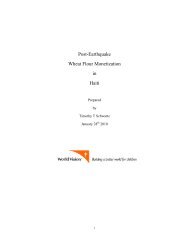Food Consumption Patterns Part 2
Create successful ePaper yourself
Turn your PDF publications into a flip-book with our unique Google optimized e-Paper software.
71<br />
Entrance of Snack <strong>Food</strong>s<br />
Manufactured snack foods are a recent phenomenon. The “snack” food market two and three<br />
decades past was almost entirely artisanal, comprised of those foods seen in the previous section.<br />
The prepackaged industrial foods that popular class Haitians in their 30s and 40s and 50s remember<br />
from childhood were condensed milk, cheese cubes, and salted crackers. Today is radically<br />
different: 91% of adults report eating prepackaged cookies, crackers, and cheese puffs (Figure<br />
14), 53% of these people eat them at least once per day (Figure 15); 78% buy them for their<br />
children (Figure 16) and 44% of them buy them for their children at least once per day (Figure 17).<br />
The new snack foods are purchased far more frequently than other non-staple imported foods, such<br />
as milk, cheese, peanut butter, and bread. In the boutik survey, 49% of shop owners reported that<br />
the most non-staple food items that adults most frequently purchased were cookies, cheese puffs,<br />
or salted crackers. In the case of children, 75% of the top sellers were cookies, cheese puffs, hard<br />
candy, chewing gum or lollipops (Table 21).<br />
It is no secret, even to many Haitians, that these foods are made of low quality ingredients. What<br />
they do not know is that the foods are composed of products deliberately stripped of nutrient—<br />
nutrients that are then be resold in other forms, typically as ingredients in higher quality foods<br />
destined for more elite consumers. In developed countries the extent to which manufacturers<br />
exploit the process is limited through state regulation<br />
and inspection. For example, in the United States,<br />
corporations that advertise as “milk” concoctions that<br />
have no animal milk in them have come under fire, been<br />
sued, fined, and forced o relabel the products so that<br />
consumers are aware of the substitution and/or<br />
modification of the word “milk.” Nothing of the sort<br />
applies in Haiti and as discussed in greater detail<br />
shortly, even the cheese cubs and condensed milk that<br />
Haitians have come to expect are sources of nutrition,<br />
have been increasingly supplemented with the same<br />
low quality ingredients found in crackers and cookies.<br />
Photo 43: Street boutik prepackaged<br />
ready-to-eat foods of Cape Haitian<br />
Photo 44: bak vendor, note the<br />
milk cans at on top<br />
Photo 45: Condensed milk for<br />
sale ‘it’s not just milk<br />
anymore’<br />
Photo 46: Street foods on the<br />
left, some of the new<br />
prepackaged ready-to-eat<br />
snacks on right
















